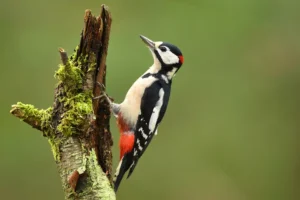There are three common types of woodpeckers in North America: the Downy Woodpecker, the Hairy Woodpecker, and the Northern Flicker. All three species have similar physical features, including a long beak, short legs, and sharp claws.
What do woodpecker holes look like? The holes that these birds make in trees are also very similar in appearance.
Most woodpecker holes are roughly an inch or two in diameter and have smooth sides. The depth of the hole varies depending on the species of bird and the type of tree.
For example, Downy Woodpeckers typically only drill shallow holes into softwoods like pine trees, while Hairy Woodpeckers will excavate much deeper cavities in harder woods like oak.
The purpose of these holes is twofold: they provide access to insects that live inside the tree trunk, and they also serve as nesting sites for the woodpeckers themselves.
In some cases, multiple birds will use the same hole for their nest; however, each pair will usually excavate their own entrance so that they can keep their territory defended from other would-be tenants.
If you’ve ever seen a woodpecker hole, you know they are distinctive. They are round and often about the size of a quarter. The edges of the hole are often jagged from the bird’s repeated pecking.
Woodpecker holes can be found in many types of trees, but they are most commonly seen in softwoods like cedar and pine. The holes are used by the birds to reach insects that are hidden under the tree’s bark.

What Kind of Holes Do Woodpeckers Make?
Woodpeckers make small, round holes in trees. The size of the hole depends on the size of the woodpecker but is typically about an inch in diameter.
Woodpeckers use their beaks to peck at the tree bark, which chips away and forms a small pile of wood shavings at the base of the hole.
How Big is a Woodpecker Hole?
A woodpecker hole typically measures between 1 and 1.5 inches in diameter. The depth of the hole depends on the type of woodpecker and the tree species.
For example, a Northern Flicker (Colaptes auratus) will excavate a nesting cavity that is about 18 inches deep in a softwood tree, whereas a Pileated Woodpecker (Dryocopus pileatus) will make a much shallower nest in a hardwood tree.
Do Woodpeckers Make Large Holes?
Woodpeckers are known for their ability to drill holes into trees. But how large of a hole can they make? The largest woodpecker in North America is the Pileated Woodpecker.
This bird can create a hole that is about 4 inches (10.16 cm) wide and up to 12 inches (30.48 cm) deep. The second-largest species is the Northern Flicker, which can make a hole that is 3 inches (7.62 cm) wide and 9 inches (22.86 cm) deep. So, yes, woodpeckers can make large holes in trees!
But it should be noted that these birds typically only drill into dead or dying trees; they very rarely damage live, healthy trees.
What Do Pileated Woodpecker Holes Look Like?
Pileated Woodpecker holes are large, round holes that are typically 3-4 inches in diameter. These holes are usually found in trees, and they serve as the bird’s nesting site.
The Pileated Woodpecker is the largest woodpecker in North America, and its powerful beak is well-suited for drilling these large holes.
What Happens When a Woodpecker Can’t Find the Food for a Long Time?
Woodpecker Holes in House
If you have woodpecker holes in your house, it’s important to take action to repair them as soon as possible. Not only are they unsightly, but they can also lead to bigger problems down the road. Water can seep into the holes and cause rot, mold, and structural damage.
Birds can also use the holes as an entry point into your home, which can lead to nesting and other pests. There are a few different ways to repair woodpecker holes.
One is to simply fill them with caulk or putty. This will seal off the hole and prevent water from getting in. Another option is to install a wire mesh over the hole.
This will deter birds from trying to enter your home and will also keep out water and debris. Whatever method you choose, it’s essential to make sure that the repair is secure so that you don’t have any more problems down the road.
Conclusion
Woodpecker holes look like small, round, perfectly-formed dents in the wood. If you were to take a close look at a woodpecker hole, you’d see that the edges are smooth and the center is slightly concave. These characteristics are what give woodpeckers their signature drilling ability.